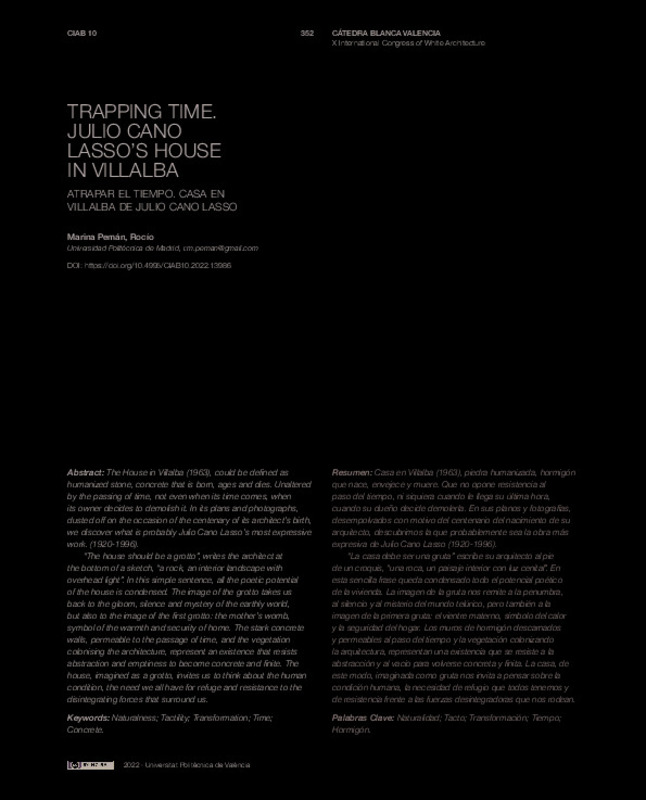JavaScript is disabled for your browser. Some features of this site may not work without it.
Buscar en RiuNet
Listar
Mi cuenta
Estadísticas
Ayuda RiuNet
Admin. UPV
Atrapar el tiempo. Casa en Villalba de Julio Cano Lasso
Mostrar el registro sencillo del ítem
Ficheros en el ítem
| dc.contributor.author | Marina Pemán, Rocío
|
es_ES |
| dc.coverage.spatial | east=-4.0055605; north=40.6308775; name=Collado Villalba, Madrid, Espanya | es_ES |
| dc.date.accessioned | 2022-09-15T09:54:20Z | |
| dc.date.available | 2022-09-15T09:54:20Z | |
| dc.date.issued | 2022-03-23 | |
| dc.identifier.isbn | 9788490483589 | |
| dc.identifier.uri | http://hdl.handle.net/10251/186105 | |
| dc.description.abstract | [EN] The House in Villalba (1963), could be defi ned as humanized stone, concrete that is born, ages and dies. Unaltered by the passing of time, not even when its time comes, when its owner decides to demolish it. In its plans and photographs, dusted off on the occasion of the centenary of its architect’s birth, we discover what is probably Julio Cano Lasso’s most expressive work. (1920-1996). “The house should be a grotto”, writes the architect at the bottom of a sketch, “a rock, an interior landscape with overhead light”. In this simple sentence, all the poetic potential of the house is condensed. The image of the grotto takes us back to the gloom, silence and mystery of the earthly world, but also to the image of the fi rst grotto: the mother’s womb, symbol of the warmth and security of home. The stark concrete walls, permeable to the passage of time, and the vegetation colonising the architecture, represent an existence that resists abstraction and emptiness to become concrete and fi nite. The house, imagined as a grotto, invites us to think about the human condition, the need we all have for refuge and resistance to the disintegrating forces that surround us. | es_ES |
| dc.description.abstract | [ES] Casa en Villalba (1963), piedra humanizada, hormigón que nace, envejece y muere. Que no opone resistencia al paso del tiempo, ni siquiera cuando le llega su última hora, cuando su dueño decide demolerla. En sus planos y fotografías, desempolvados con motivo del centenario del nacimiento de su arquitecto, descubrimos la que probablemente sea la obra más expresiva de Julio Cano Lasso (1920-1996).“La casa debe ser una gruta” escribe su arquitecto al pie de un croquis, “una roca, un paisaje interior con luz cenital”. En esta sencilla frase queda condensado todo el potencial poético de la vivienda. La imagen de la gruta nos remite a la penumbra, al silencio y al misterio del mundo telúrico, pero también a la imagen de la primera gruta: el vientre materno, símbolo del calor y la seguridad del hogar. Los muros de hormigón descarnados y permeables al paso del tiempo y la vegetación colonizando la arquitectura, representan una existencia que se resiste a la abstracción y al vacío para volverse concreta y finita. La casa, de este modo, imaginada como gruta nos invita a pensar sobre la condición humana, la necesidad de refugio que todos tenemos y de resistencia frente a las fuerzas desintegradoras que nos rodean. | es_ES |
| dc.format.extent | 10 | es_ES |
| dc.language | Español | es_ES |
| dc.language | Inglés | es_ES |
| dc.publisher | Editorial Universitat Politècnica de València | es_ES |
| dc.relation.ispartof | CIAB 10. X Congreso internacional arquitectura blanca | |
| dc.rights | Reconocimiento - No comercial - Compartir igual (by-nc-sa) | es_ES |
| dc.subject | Naturalness | es_ES |
| dc.subject | Tactility | es_ES |
| dc.subject | Transformation | es_ES |
| dc.subject | Time | es_ES |
| dc.subject | Concrete | es_ES |
| dc.subject | Naturalidad | es_ES |
| dc.subject | Tacto | es_ES |
| dc.subject | Transformación | es_ES |
| dc.subject | Tiempo | es_ES |
| dc.subject | Hormigón | es_ES |
| dc.title | Atrapar el tiempo. Casa en Villalba de Julio Cano Lasso | es_ES |
| dc.title.alternative | Trapping time. Julio Cano Lasso’s House in Villalba | es_ES |
| dc.type | Capítulo de libro | es_ES |
| dc.type | Comunicación en congreso | es_ES |
| dc.identifier.doi | 10.4995/CIAB10.2022.13986 | |
| dc.rights.accessRights | Abierto | es_ES |
| dc.description.bibliographicCitation | Marina Pemán, R. (2022). Atrapar el tiempo. Casa en Villalba de Julio Cano Lasso. En CIAB 10. X Congreso internacional arquitectura blanca. Editorial Universitat Politècnica de València. 352-361. https://doi.org/10.4995/CIAB10.2022.13986 | es_ES |
| dc.description.accrualMethod | OCS | es_ES |
| dc.relation.conferencename | 10º Congreso Internacional de Arquitectura Blanca - CIAB 10 | es_ES |
| dc.relation.conferencedate | Marzo 23-25, 2022 | es_ES |
| dc.relation.conferenceplace | València, España | es_ES |
| dc.relation.publisherversion | http://ocs.editorial.upv.es/index.php/CIAB/CIAB10/paper/view/13986 | es_ES |
| dc.description.upvformatpinicio | 352 | es_ES |
| dc.description.upvformatpfin | 361 | es_ES |
| dc.type.version | info:eu-repo/semantics/publishedVersion | es_ES |
| dc.relation.pasarela | OCS\13986 | es_ES |








